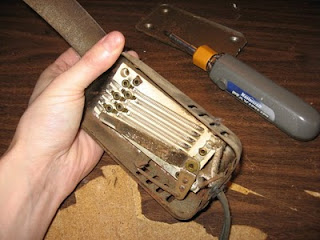Open the thingy and look inside.
If it's dirty: Clean it.
If a piece is loose: Push or bend it back in place.
If a piece is visibly broken: Make a new one or replace it with part from another dead thingy.
If a circuit was visibly burned: Replace it with the same part from another dead thingy or declare that one dead but keep it for the parts.
With this check list, you were able to go a long way before throwing something away. So I kept on fixing keyboards, mouses, laptops and PCs for years. Then one of my Natural-Keyboards broke. “No problem!” I was thinking, getting my tools out. It's been a long time and couldn't wait to see what it looked like inside. It was a shock. There's nothing in there. It was two pieces of clear plastic sheets, one of top of the other, covering the space under all the keys. Imbedded in the plastic is a bunch of circuits lines and by pressing the two plastic layers, lines on each layers would form a contact. It was not dirty, there was no pieces to get loose and it was not visibly broken or burned. I was screwed. 'So long' my 120.00$ keyboard and 'Hello' the cheapo 19.99$ keyboard. Yet another reminder of to the consuming world.
Nowadays if something breaks, most of the time we throw it away. If we bother to open the thing, it often brakes in the process since it's not meant to be opened. Once inside, we look at the one chip that, somehow, does everything in-there and sigh before throwing the pile of pieces in the garbage.
I like to fix things. Most of our tables, desks and cupboards in the house are nice old things having a second life. Not that long ago, my wife came home with an old sowing desk that we turned it into a side table in the living room. While fixing it I remove the sowing machine pedal that was still attached inside the desk.

It was begging me to open it and so I did.

It was simple swivel harm that could make contact at five different places on one long coil resistor, or be in the 'fully on' position or the 'fully off' position.

I had a mixture of emotions. I started by being impressed with the simplicity. I knew I could fix that and I knew I could use that design in an eventual project. I was also angry that things are not made like that anymore.
google 2865
ReplyDeletegoogle 2866
google 2867
google 2868
google 2869